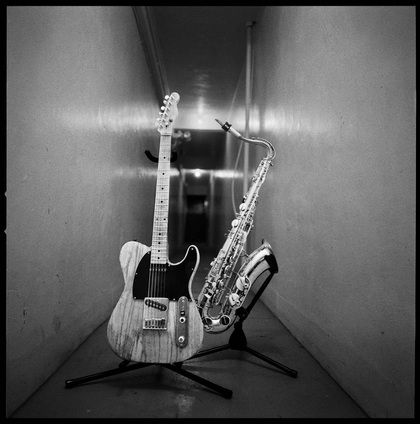I’m a big fan of the hungarian minor scale because like most exotic scales, it steps outside the stable harmony of the major scale, but unlike most exotic scales, it’s still very usable. There’s just something mysterious about it, and although it’s only one note different from the harmonic minor scale, it sounds much less obvious and far less cheesy. The hungarian minor scale is also relatively comfortable to play on the guitar fretboard with accessible fingerings available in almost any area of the neck. What I really like about it though are the chords it spawns that bend all the rules, which can in turn stimulate your creativity and allow you to come up with some interesting stuff in no time at all. Let’s check it out.
Here’s how the hungarian minor scale looks in A on fretboard. It contains the following intervals: 1, 2, b3, #4, 5, b6, 7, which create a nice tension over minor chords.

Chords Galore
If you take a closer look you should see a few familiar chords emerge, with plenty of barre chords among them:
Am, Adim, Asus2, Amadd9, AmMaj7, AmMaj9,
B7b5
Caug, Cmaj7#5,
E Major, Emaj7, Eaug, Esus4, Emaj7#5
Fm, F Major, Fm7b5, Fmaj7, F7, Fm7, Fmaj7b5, F7b5, F7#9, FmMaj7, Fmaj7b5, Fdim
G#m, G#6, G#m6, G#aug,
What immediately leaps out here are the sheer amount of F chords that are available. You have both the major and the minor, plus the dominant 7, the major and minor 7, and a whole host of others. If you’ve ever wondered how you could combine these chords and not have to worry about breaking your head to improvise over them, there’s your answer. This is one of the creative benefits of exotic scales: they bring together groups of chords you perhaps wouldn’t have thought about combining, while giving you a structure within which to be creative.
Power Chords
If the above chords seem a little daunting, it’s worth remembering that you can still explore exotic scales like this one by extracting the power chords, both 5s (1, 5) and -5s (1, b5):
A5, B-5, D#-5, E5, F5, G#5
Simply arrange the above power chords to your liking or come up with a riff or two based off them, and you can freely use the Hungarian Minor to solo over them.
Let the Fun Begin
Here are a couple of backing tracks I came up with. The first one uses the following chords:
Am | Am | Amadd9 | Asus2
Fmaj7 | Fmaj7 | Am | Am
Cmaj7#5 | Cmaj7#5 | A5 | A5
F7 | F7 | Esus4 | E
Am | Am | Adim | Adim
F(b5) | Fmaj7(b5) | Am | Am
Cmaj7#5 | Cmaj7#5 | A5 | A5
F7b5 | F7b5 | Emaj7#5 | E
The second backing track is a funkier one based on the following chords:
A5 | A5 | E5 | F5
A5 | A5 | E5 | F5
A5 | A5 | B(b5) | B(b5)
A5 | A5 | E5 | F5
B(b5) | B(b5) | A5 | A5
E5 | E5 | E5 | E5
B(b5) | Caug Ddim | E5 | E5
If this is your first time experimenting with this scale, make sure to spend some time getting a feel for it as you’ll need to rethink your note placement and phrasing in general. There’s a lot of tension to explore here too, but you’ve also got that strong E to A resolution which I used in both the backing tracks, so make the most of those tension building chords when coming up with your own progressions.
For a thorough look at 15 exotic scales and modes, check out the Intermediate Scales Handbook – Exotic Scales Edition.



